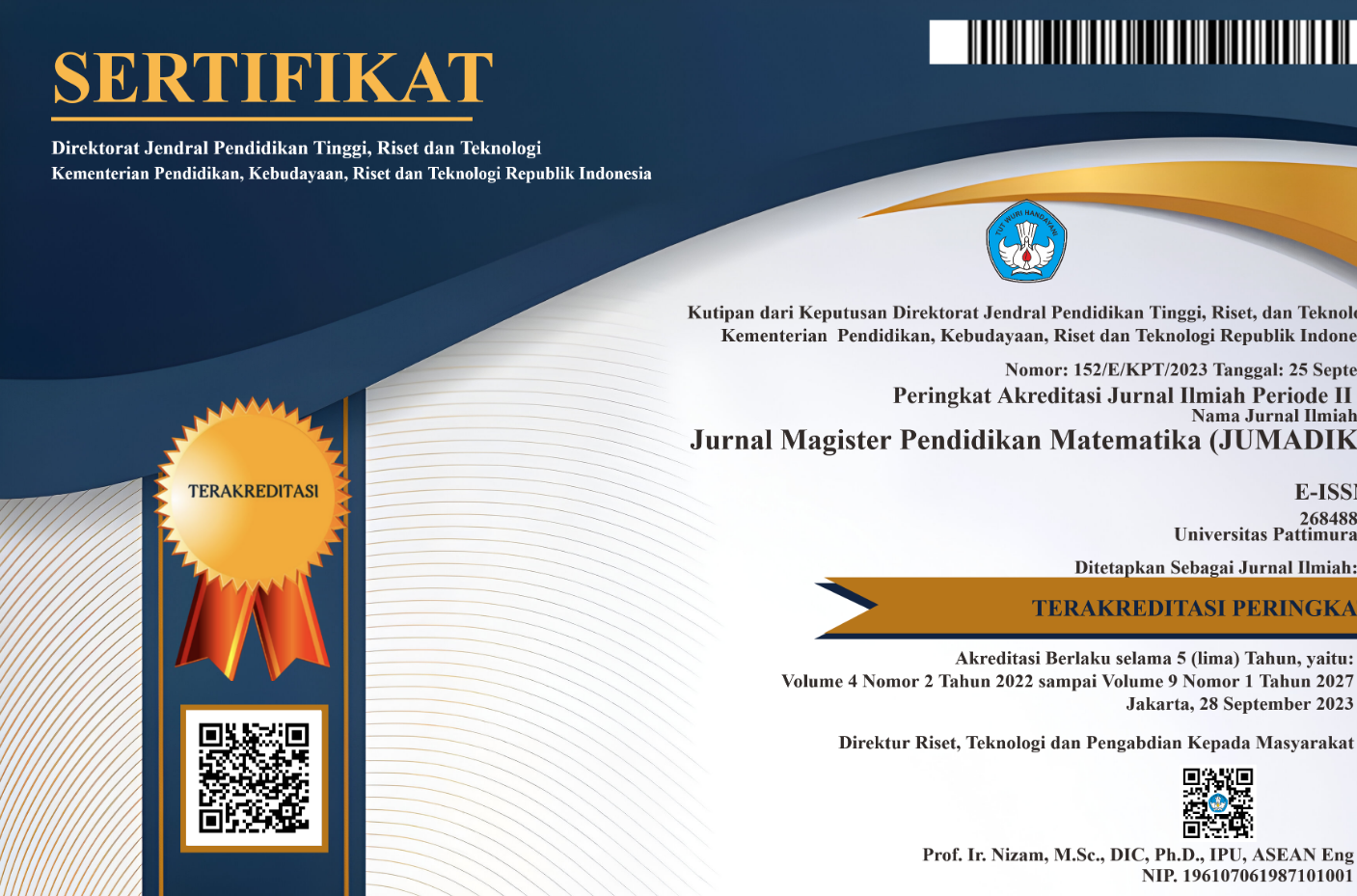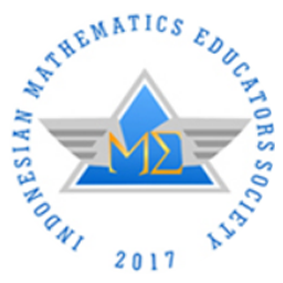INTUISI SEBAGAI SALAH SATU SOLUSI MERAIH PRESTASI BELAJAR MATEMATIKA
Abstract
Mathematical problems are often solved without using conventional methods but using intuition thinking. Intuitive thinking is a cognitive process that leads to ideas as strategies for making decisions that produce spontaneous answers in solving problems. Spontaneous answers are written and spoken expressions that help a person solve math problems without using analytical thinking. This study aims to describe the various forms of intuition that arise when students solve math problems. The research method used is descriptive qualitative method to describe students' intuitive thinking processes through test instruments and interviews. The results showed that the form of intuitive thinking that emerged was (1) affirmatory intuition, namely direct cognition to understand the problem and (2) perceptual and global components, because students made perceptions of the answer solutions to be generated, then resolved until they got the results. In addition, it was also found that intuitive thinking that is raised as a strategy in making decisions is based on feelings, intrinsics and interventions to produce answers to solving the problems faced
Downloads
References
Admin. (2013). Intuition and critical thinking. Articles Tab, K-12 instruction strategies. Bookmark the permalink. university of New Mexico.
Arifin (1998). Proses Komunikasi antara Pendidik dan Anak Didik. Jakarta: UT
Creswell, John W. (2012). Designing and Conducting Mixed Methods Research. USA: Sage publication, Inc.
Fischbein, E. (1987). Intuition in science and mathematics An educational approach, Reidel, The Netherlands
Freudenthal, H. (1991). Refisiting mathematics education. China Lectures. Dordrecht: Kluwer
Henden, G. 2004. Intuition and Its Role in Srategi Thingking. Unpublished Dissertation. BI Norwegian. Sage Publications, Inc.
Herry, Debra. (2007). Developing Thinking Developing Learning. Poland: Open University Press.
Hudoyo, H. (2008). Mengajar Belajar Matematika. Dirjen Dikti, Jakarta, Depdikbud.
Kemp, Jerold E, alih bahasa: Asril Marjohan (1994). Proses Perancangan Pengajaran. Bandung: ITB Bandung.
Kustos, P.N. 2010. Trens Concerning Four Misconception In Students’ Intuitively-Based Probabilistic Reasoning Sourced In The Heuristic Of Representativeness. (http//udini.proquest.com/view/trends-concerning-four). Di akses 13 April 2013.
Marpaung, Y. (2001). Prospek RME untuk Pembelajaran Matematika. Makalah disampaikan pada seminar nasional PMRI di Universitas Sanata Dharma, Yogyakarta 14-15
Moleong, Lexy, J. 2006. Metodologi Penilaian Kualitatif, Direktorat Jenderal Pendidikan Tinggi. Departemen Pendidikan Nasional. Bandung.
Peter, M. (2008). A Study of “Open †Approach†Method in School Mathematics Teaching – Focusing On Mathematical Problem Solving Activities http://www.nku.edu/~sheffield/nohda.html. [13 Oktober 2014].
Sao, Sofia. 2014. Berpikir Intuitif Dalam Pembelajaran Matematika. Prosiding Seminar Nasiona TEQIP (Teachers Quality Improvement Program) Membangun Karakter Bangsa melalui Pembelajaran Bermakna Universitas Negeri Malang 2014.
Slavin, Robert E. (1994). Educational Psychology: Theories and Practiece, Fourt Edition. Masschussets: Allyn and Bacon Publishers.
Soedjadi, R. (2001). Masalah kontekstual sebagai batu sendi matematika sekolah. Departemen Pendidikan Nasional UNESA. Surabaya.
Soedjadi, R. (2006). Kiat Pendidikan Matematika di Indonesia. Dirjen Dikti. Jakarta Depdikbud.
Solso Robert L., (2012) Psikologi Kognitif. Jakarta: Erlangga,
Taplin, A. (2010). Extensional versus intuitive reasoning: The conjunction fallacy in probability judgment. Psychological Review, 90(4), 293-315.
Usodo, Budi. (2011). Karakteristik Intuisi Siswa SMA dalam Memecahkan Masalah Matematika Ditinjau dari Kemampuan Matematika dan Perbedaan Gender. Surakarta: Perpustakaan FKIP UNS.
Voskoglou, Michael Gr. (2006). Formalism and intuition in mathematics: The role of the problem. Quaderni di Ricerca in Didattica. Italy
Weintraup, E. (1998). Awakening Intuition. New York: Anchor Books.
Yuwono, Ipung. 2001. RME (Realistic Mathematics Education) dan hasil Studi awal Implementasinya dan SLTP. Makalah disajikan pada Seminar Nasional Realistic Mathematics Education (RME) dan Jurusan FMIPA UNESA tanggal 24 Februari 2001.
Copyright (c) 2020 Sofia Sa’o

This work is licensed under a Creative Commons Attribution-NonCommercial-ShareAlike 4.0 International License.
License and Copyright Agreement
In submitting the manuscript to the journal, the authors certify that:
- They are authorized by their co-authors to enter into these arrangements.
- The work described has not been formally published before, except in the form of an abstract or as part of a published lecture, review, thesis, or overlay journal. Please also carefully read Jurnal Magister Pendidikan Matematika (JUMADIKA) Posting Your Article Policy.
- That it is not under consideration for publication elsewhere,
- That its publication has been approved by all the author(s) and by the responsible authorities – tacitly or explicitly – of the institutes where the work has been carried out.
- They secure the right to reproduce any material that has already been published or copyrighted elsewhere.
- They agree to the following license and copyright agreement.
Copyright
Authors who publish with Jurnal Magister Pendidikan Matematika (JUMADIKA) agree to the following terms:
- Authors retain copyright and grant the journal right of first publication with the work simultaneously licensed under a Creative Commons Attribution-NonCommercial-ShareAlike 4.0 International License (http://creativecommons.org/licenses/by-nc-sa/4.0/) that allows others to share the work with an acknowledgment of the work's authorship and initial publication in this journal.
- Authors are able to enter into separate, additional contractual arrangements for the non-exclusive distribution of the journal's published version of the work (e.g., post it to an institutional repository or publish it in a book), with an acknowledgment of its initial publication in this journal.
- Authors are permitted and encouraged to post their work online (e.g., in institutional repositories or on their website) prior to and during the submission process, as it can lead to productive exchanges, as well as earlier and greater citation of published work.








